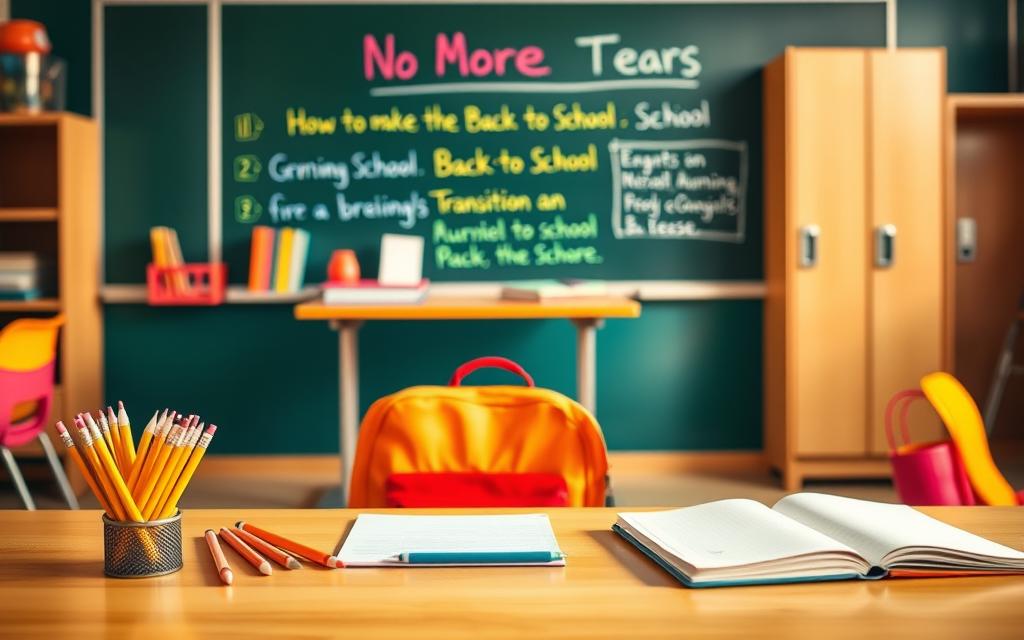The back-to-school transition can be a challenging time for both children and parents. The shift from a relaxed summer routine to a structured school schedule can be daunting.
A smooth back-to-school transition is crucial for setting a positive tone for the academic year. It involves school transition strategies that simplify the process, making it less stressful for families.
This article will guide you through stress-free back-to-school tips and back-to-school preparation ideas, helping you create a school readiness guide tailored to your family’s needs.
The Back-to-School Challenge: Why Transitions Can Be Tough
The shift from summer fun to school days can be a significant source of stress for children and parents alike. As the carefree days of summer vacation come to an end, kids must adjust to a new routine that includes early wake-up times, homework, and social interactions.
Academic Anxiety and Social Concerns
Children often worry about the upcoming school year, feeling anxious about academic performance and social relationships. Back-to-school anxiety can stem from concerns about making new friends, dealing with bullies, or meeting teacher expectations.
Routine Disruption Effects
The disruption of the summer routine can be challenging for kids. Adjusting to earlier bedtimes and morning wake-ups can be difficult, affecting their overall mood and behavior.

Parents should be aware of behavioral changes in their children, such as irritability, clinginess, or withdrawal. These signs can indicate that a child is struggling with the transition.
Physical Symptoms of School-Related Stress
Some children may exhibit physical symptoms like headaches, stomachaches, or loss of appetite due to school-related stress. Recognizing these signs early can help parents provide the necessary support.
By understanding these challenges, parents can better prepare their children for the back-to-school transition, making it less stressful and more manageable.
No More Tears: How to Make the Back-to-School Transition a Breeze
As the new school year approaches, parents can play a significant role in making the transition a positive experience for their children. A well-planned transition can set the tone for a successful and stress-free school year.
Why Predictability Matters to Children
Children thrive on routine, and predictability is key to reducing anxiety. Establishing a consistent daily schedule helps children feel secure and in control. Predictable routines can make the back-to-school transition smoother by providing a sense of stability.

Positive transitions build resilience in children. By gradually introducing school-year routines, such as earlier bedtimes and homework schedules, parents can help their children adjust more easily. Positive reinforcement and encouragement also play a crucial role in building confidence.
Elementary School Transition Needs
For elementary school children, the transition involves adjusting to new classrooms, teachers, and potentially new schools. Visiting the school before the first day and meeting the teacher can help alleviate concerns. Establishing a morning routine that includes time for a healthy breakfast and getting ready can also reduce stress.
Middle and High School Considerations
Older students face different challenges, such as managing more complex schedules and increased academic expectations. Helping them develop organizational skills and time management strategies can make a significant difference. Encouraging them to get involved in extracurricular activities can also enhance their school experience.
By understanding the specific needs of their children and implementing these strategies, parents can make the back-to-school transition a breeze, setting their children up for success in the new school year.
Early Preparation: Your 4-Week Back-to-School Timeline
To ensure a stress-free back-to-school experience, it’s essential to have a solid preparation timeline in place. Starting four weeks before the new school year begins allows you to tackle various tasks gradually, making the transition smoother for both you and your child.
Creating Your School Supply Checklist
Begin by making a comprehensive back-to-school checklist that includes all necessary supplies, from pencils and notebooks to backpacks and lunchboxes. Involve your child in this process to ensure you get everything they need.
Involving Your Child in the Planning Process
Involving your child in the planning process not only makes them feel more in control but also helps you understand their needs and preferences better. Let them help with tasks like picking out school supplies or deciding on a new backpack.
Start adjusting your child’s bedtime a week or two before school starts to ease them into the new schedule. Gradually move their bedtime earlier by 15-minute increments every few days until they are sleeping at a reasonable hour for school.
Morning Wake-Up Strategies
Implement a consistent morning wake-up routine to help your child adjust to waking up early for school. Use a gentle wake-up light or a favorite morning song to make waking up more pleasant.
School Route Trial Runs
Conduct a few trial runs of the school route to familiarize your child with the path and to identify any potential issues, such as traffic hotspots or construction.
Meal and Homework Schedule Practice
Establish a routine for meals and homework to help your child settle into the school year rhythm. Practice this schedule a week or two before school starts to make the transition smoother.
School Visit Opportunities
Arrange a visit to the school before the year begins, if possible. Many schools offer orientation days or open houses that can help your child become familiar with their new classroom and teachers.
Celebrating the End of Summer
Finally, don’t forget to celebrate the end of summer with a fun activity or outing. This can be a great way to mark the transition and create positive memories.
By following this 4-week timeline and involving your child in the back-to-school preparation process, you can ensure a smooth and stress-free transition into the new school year.
Creating Stress-Free Morning Routines
Establishing a stress-free morning routine is crucial for a successful school year. A well-planned morning can set a positive tone for the day, helping children feel more prepared and focused.
Outfit Selection and Backpack Readiness
Prepare your child’s outfit and backpack the night before to save time and reduce morning stress. This simple step can make a significant difference in creating a smooth morning routine. By doing so, you’ll ensure that everything is ready to go, making mornings more manageable.
Preparing lunches and snacks in advance can be a game-changer for busy mornings. Consider using a slow cooker or meal prep containers to keep healthy snacks ready. This helps in maintaining a stress-free back-to-school environment.
Visual Schedules for Younger Children
For younger children, visual schedules can be incredibly helpful. Create a chart or poster that outlines the morning routine, including tasks like brushing teeth and getting dressed. This visual aid can help them stay on track and develop a sense of responsibility.
Digital and Responsibility-Based Systems for Older Students
Older students can benefit from digital calendars and responsibility-based systems. Encourage them to take ownership of their morning routine by setting reminders and alarms. This helps in developing a school morning routine that is both efficient and stress-free.
By implementing these strategies, you can create a kids school routine that promotes a positive start to the day. Effective back-to-school organization is key to a stress-free morning routine.
Addressing Back-to-School Anxiety and Emotions
As the new school year approaches, many children experience anxiety and stress, making the transition back to school a challenging time for families. It’s essential for parents to address these emotions and help their children develop coping strategies.
One effective way to help children manage their anxiety is by asking open-ended questions that encourage them to share their feelings. Questions like “What are you looking forward to this school year?” or “What worries you about going back to school?” can help parents understand their child’s concerns.
Active Listening Techniques for Parents
Active listening is crucial when discussing back-to-school anxiety with children. Parents should give their full attention, maintain eye contact, and avoid interrupting. This helps children feel heard and understood, reducing their anxiety.
Role-Playing Difficult School Scenarios
Role-playing can be a helpful tool in preparing children for challenging situations they might face at school. By practicing different scenarios, children can build confidence and develop strategies to handle difficult situations.
Creating Positive Affirmations and Coping Strategies
Teaching children positive affirmations and coping strategies can help them manage back-to-school anxiety. Encouraging positive self-talk and providing tools like deep breathing exercises or visualization techniques can empower children to handle stressful situations.
By implementing these strategies, parents can help their children navigate the challenges of back-to-school anxiety and make the transition to a new school year smoother.
Organization Systems That Make School Life Easier
As the new school year begins, establishing effective organization systems can make a significant difference in your child’s academic success. A well-organized home and study space help reduce stress and improve productivity.
Creating a dedicated study area with essential supplies is vital. This includes a desk, chair, good lighting, and a school supplies checklist to ensure everything needed is available.
Distraction-Free Environment Creation
A distraction-free environment is crucial for effective studying. This can be achieved by minimizing clutter, using noise-cancelling headphones, and implementing a “no screen” rule during study hours.
Family Calendar Systems That Work
Implementing a family calendar system helps keep track of school events, assignments, and extracurricular activities. Digital calendars like Google Calendar or Apple Calendar can be shared among family members.
Digital Tools for School-Home Communication
Digital tools for school facilitate communication between parents and teachers. Apps like Remind, ClassDojo, or Bloomz allow teachers to share updates, assignments, and photos with parents.
By implementing these organization systems, you can create a structured and supportive environment that fosters academic success and reduces stress for both children and parents.
Nutrition and Health: Fueling Success in the Classroom
Healthy eating habits and adequate sleep are essential for a child’s academic performance and overall well-being. Ensuring that your child is well-nourished and gets enough rest can make a significant difference in their ability to succeed in school.
Quick Protein-Rich Options
Starting the day with a protein-rich breakfast can help keep your child energized and focused. Consider quick and easy options like scrambled eggs, Greek yogurt, or peanut butter on whole-grain toast.
Make-Ahead Breakfast Solutions
Preparing breakfast in advance can save time during busy mornings. Try making overnight oats or breakfast burritos that can be reheated on busy mornings.
A balanced lunch should include a mix of protein, healthy fats, and complex carbohydrates. Aim for a variety of foods, such as lean meats, whole grains, and a range of colorful vegetables.
Batch Preparation Methods
Batch cooking on the weekends or one day a week can help ensure that you have healthy meals ready for the week. Consider making a big batch of soup or stew that can be portioned out into individual servings.
Age-Appropriate Sleep Needs
Adequate sleep is crucial for a child’s health and academic performance. The National Sleep Foundation recommends that children aged 6-13 years old get 9-11 hours of sleep per night.
Creating Bedtime Routines That Work
Establishing a consistent bedtime routine can help signal to your child that it’s time to sleep. This can include activities like reading, storytelling, or relaxation techniques.
By focusing on nutrition and sleep, you can help your child succeed in school and develop healthy habits that will last a lifetime.
Conclusion: Setting the Stage for a Successful School Year
As the new school year approaches, parents can take a deep breath knowing they’ve prepared their children for a smooth transition. By implementing the back-to-school success strategies outlined in this guide, families can establish a strong foundation for a successful school year.
Effective school year readiness involves more than just buying school supplies. It’s about creating a stress-free morning routine, addressing back-to-school anxiety, and fueling young minds with nutritious food. By incorporating these elements, parents can help their children navigate the challenges of the new school year with confidence.
A smooth transition to school is within reach when parents are equipped with the right tools and mindset. This back-to-school guide has provided a comprehensive roadmap for achieving a successful school year. By following these tips and staying committed to their goals, families can set themselves up for a year of academic success and personal growth.







